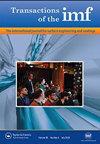使用脉冲电流技术电沉积铂
IF 1.5
4区 材料科学
Q4 ELECTROCHEMISTRY
Transactions of The Institute of Metal Finishing
Pub Date : 1999-01-01
DOI:10.1080/00202967.1999.11871261
引用次数: 0
摘要
脉冲镀的范围已经在铂镀层的制造生产的背景下被定义。研究了电解质变量对P盐溶液电流效率的影响。比较了常规电流和脉冲电流下的沉积性能,并注意到电流效率的提高。本文章由计算机程序翻译,如有差异,请以英文原文为准。
The use of pulsed current techniques for electrodeposition of platinum
The scope of pulse plating has been defined in the context of the manufacturing production of platinum electrodeposits. The influence of electrolyte variables on the current efficiency has been investigated for P salt solution. Deposition performances under conventional and pulsed current have been compared and increases in current efficiency noted.
求助全文
通过发布文献求助,成功后即可免费获取论文全文。
去求助
来源期刊

Transactions of The Institute of Metal Finishing
工程技术-材料科学:膜
CiteScore
3.40
自引率
10.50%
发文量
62
审稿时长
3 months
期刊介绍:
Transactions of the Institute of Metal Finishing provides international peer-reviewed coverage of all aspects of surface finishing and surface engineering, from fundamental research to in-service applications. The coverage is principally concerned with the application of surface engineering and coating technologies to enhance the properties of engineering components and assemblies. These techniques include electroplating and electroless plating and their pre- and post-treatments, thus embracing all cleaning pickling and chemical conversion processes, and also complementary processes such as anodising. Increasingly, other processes are becoming important particularly regarding surface profile, texture, opacity, contact integrity, etc.
 求助内容:
求助内容: 应助结果提醒方式:
应助结果提醒方式:


